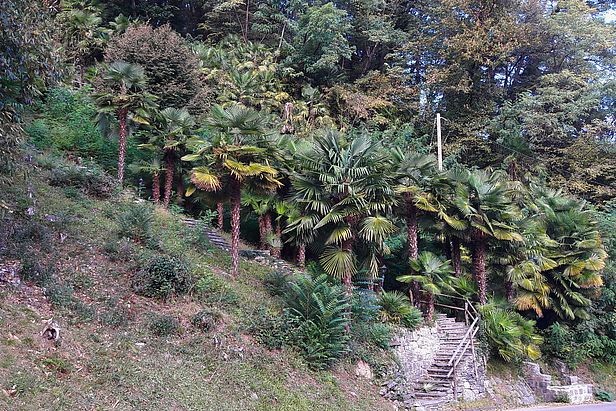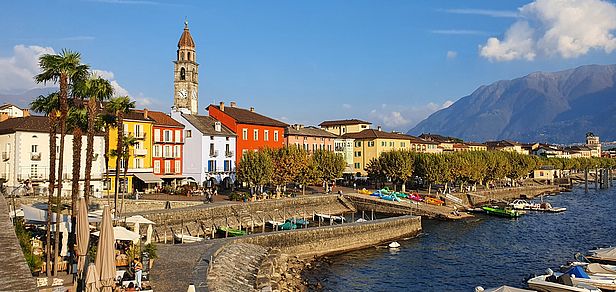14.03.2023 | Gottardo Pestalozzi | News WSL
The Chinese windmill palm (Trachycarpus fortunei), a popular postcard subject in the southernmost Swiss canton, originates from Asia and is extremely resistant to cold. The Swiss Federal Institute for Forest, Snow and Landscape Research WSL has now investigated the potential impact of its massive spread in the forests of Ticino and proposes targeted control measures.
Given the spread of the Chinese windmill palm (Trachycarpus fortunei), Ticino's forests near residential areas now almost look tropical. The palms, which have been planted in gardens over the last 50 years, have proliferated and in some places are displacing native plant species. WSL researchers have now investigated, as part of the federal pilot programme "Adaptations to Climate Change", how climate change is influencing this process and what effects this could have on the affected forests. The final report is published today by the Federal Office for the Environment.
The windmill palm changes the forest and its functions ¶
The research team studied the flora and fauna at ten forest sites each with a high palm density or without any palms at all. The palm-rich sites did not contain fewer invertebrates, but significantly fewer plant species. Windmill palms also weaken the protective function of forests against natural hazards: Their root system strengthens the soil only slightly, so a pure palm stand would be unfavourable as a protective forest. This is of little consequence in mixed forests, and on steep, rocky sites where hardly any other trees grow, the palm can even protect against rockfall. Since many dry, dead leaves accumulate on the windmill palms, the researchers also regard an increased risk of forest fires as probable.
The distribution is concentrated in areas close to settlements. ¶
At present, the Chinese windmill palm is restricted to the forests at lower altitudes (< 900 m above sea level). In the future, however, it will also be able to colonise somewhat higher altitudes if it gets warmer there with climate change. The WSL researchers assume that the palm will continue to spread strongly in the vicinity of settlements. In forests far from settlements, on the other hand, they expect only a slow spread. Since the seed production of the windmill palm is limited to shady forests, extensive and dense stands are unlikely there.
Appreciation need for containment are equally distributed ¶
In addition to the field and laboratory studies, the researchers conducted a nationwide survey on the public's perception of Trachycarpus fortunei. Most of the 2,000 participants perceive the windmill palm positively and as a Ticino landmark. While bans would receive little support, there is definitely agreement for recommendations that would limit the further spread of the palm (e.g. remove flowers and fruits, remove stray plants, plant alternative non-invasive palm species).
WSL develops method for targeted control ¶
Communication measures do raise public awareness of the need to deal with the popular ornamental plant in a responsible manner. But it is still essential to keep palm populations in check, even if their complete elimination from forests near settlements is unrealistic. The researchers recommend making the local ecosystem completely palm-free again at certain ecologically valuable sites (for example in floodplain forests) and thinning out the palm population in protection forests where it makes sense.
To eliminate escaped windmill palms, WSL has developed and tested a time- and cost-efficient method: On the one hand, a close-to-the-ground cut with a chainsaw causes adult palms to die directly. However, this treatment is inadequate for young palms, because they sprout again from the palm heart remaining in the ground. To prevent this, the heart should be destroyed with a drill. The canton of Ticino now officially recommends the method and experts apply it.
Always up to date: Subscribe to the WSL Newsletter
Contact ¶
Publications ¶
Copyright ¶
WSL and SLF provide the artwork for imaging of press articles relating to this media release for free. Transferring and saving the images in image databases and saving of images by third parties is not allowed.



